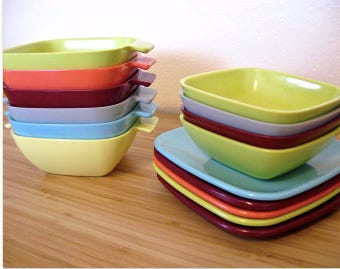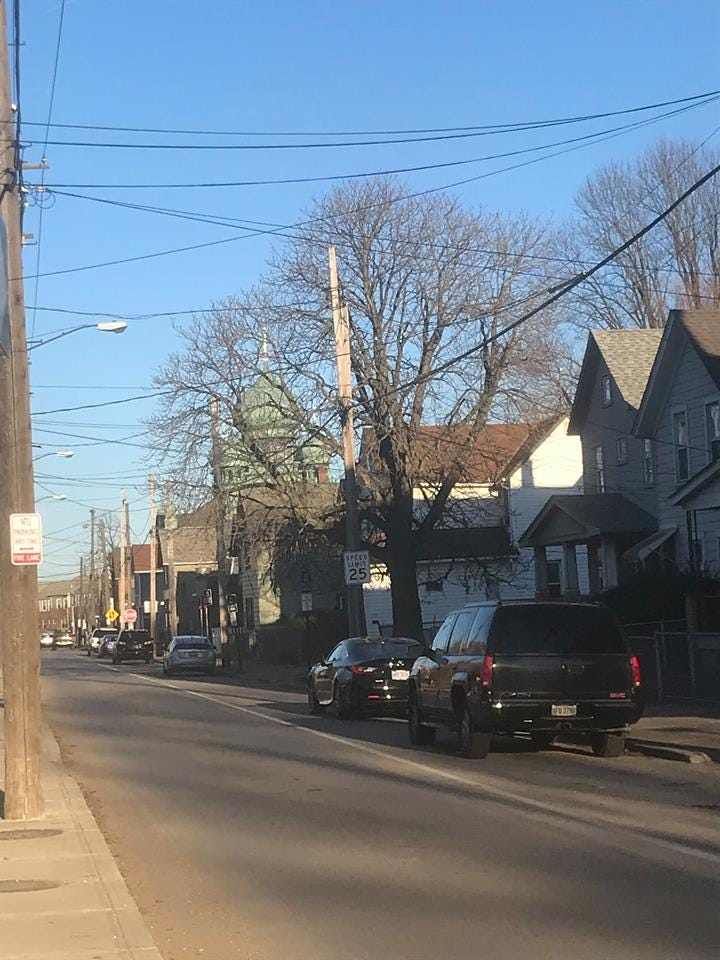I would not have guessed late April/early May would be the week I skipped a chronicle, failing on my pledge to write at least once per week, but so it is. Blame the crappy weather, blame the too-many-delayed-flights and too-many-trips here and there. I’m back.
I have been thinking a lot about industrial design, and the robust role Clevelanders have had in developing aesthetics over the decades. A few weeks ago I wrote about my thrifting hobby (what’s that? did you say obsession?). After I wrote the post, which revealed my deepest secrets, I could not help but hit the Goodwills. And then, some Cleveland karmic grace: I discovered a cache of gorgeously designed melamine tableware. Bright mid-century colors, cool modernist lines. I bought sixty piece (at fifty cents per), brought them home, turned over the plates, and googled the hallmark.
The tableware was designed by Joan Luntz, a phenomenally talented woman who lived in Shaker Heights and had a very successful career as a designer. The best writing I have found on Luntz is in the Plain Dealer (oh for more well-written, researched obituaries like these in the local paper ), and the Wall Street Journal also wrote a good piece. Here’s a nice write-up of her pieces in the Museum of Fine Arts in Boston. There should be more to read about Luntz, and I might see if I can rectify that sometime soon.


Luntz’ melamine does not command high prices, and I think that’s a shame, and not because I want to cash in. Can we start a trend in collecting overlooked women midcentury industrial designers, and boost her value? I mean, look. Beautiful.
The beautiful, for those of you have been following my musing on ruin porn here, here, and here, is one way to understand what the sublime is not. Let’s go back to our favorite video, explaining Edmund Burke’s distinction between the two. Beautiful is Rose Iron Works. Beautiful is Pewabic Pottery. (yup, not just Cleveland but all the Rust Belt that define the industrial aesthetics I’m reaching for here). Beautiful is Joan Luntz. Beautiful is, of course, Viktor Schreckengost.
After my high from finding, researching, and discovering Joan Luntz, I may have, um, gone back out, the next day, for further sleuthing. Now, before I tell you this story, I’ll tell you another one. For the past year or two, I’ve been debating my tenure in Cleveland; should I stay? Move? Empty nesting will do that to you. I decided to move to Tremont a year ago, and I have slowly sunk into a pleasant routine here overlooking the mills. I love the tiny block I live on, in a tiny millworkers’ house across from poorly constructed overpriced condos. I am a block or two from some of the best Russian Orthodox architecture in the country.
So on my fourth stop on a Sunday, I stumbled into another thrift shop near my own stomping grounds on the east side, and, lying against a bunch of other art leaning against the counter I found the view from my living room window.

If I could just cut out the wall:


Beautiful, isn’t it? I gives me pleasure; it assuages my ambivalence. I think I will renew the lease.
I adore Schreckengost, and is April from a 1980 calendar he did for the International Printing Corporation (there is strangely not enough about Schreckengost’s prints and paintings online, I find; here’s the best link I found to the calendar.)
As our weather moves from sublime to beautiful, so will these chronicles, as I take these preliminary notes and expand them towards defining Cleveland industrial design aesthetics. Send me links.
Cleveland Chronicles is a record of life in Cleveland throughout 2019 as filtered through the lens of the chronicler. Forward this email to a friend, and pay a few books if you want to read previous posts or because you believe in paying for content.

